"Morning bells and evening drums, imperial city and civil administration". Beijing Central Axis which is connected by many cultural relics showcases the charm of the imperial city that has lasted for hundreds of years. "Extending to the south and north, and running through to the end", the Central Axis leads the layout of the streets and alleys of the imperial capital.
"An 8-km-long north-south central axis, the longest and greatest in the world, runs through the city. Beijing's unique magnificent order was created by the establishment of this central axis," noted Liang Sicheng.
The Central Axis of Beijing is an important witness of the Chinese civilization and cultural tradition. After hundreds of years of vicissitudes, it slowly opens a new chapter as Beijing has made progress in the application for the axis to be included in the list of world cultural heritage sites. Do other cities around the world also have central axes? Is the Champs-Elysees avenue the central axis of Paris? Does the central axis of Berlin pass through the Brandenburg Gate? Is Washington's central axis an extension of the monument? Is the central axis of Teotihuacan the "Avenue of the Dead"? Why does Guangzhou have old and new central axes? What are the similarities and differences between these central axes and Beijing Central Axis? Do they still exist?
With curiosity about the great variety of questions, join UNESCO International Center for Creativity and Sustainable Development (ICCSD) to explore the "Urban Central Axes" at home and abroad in the themed series!
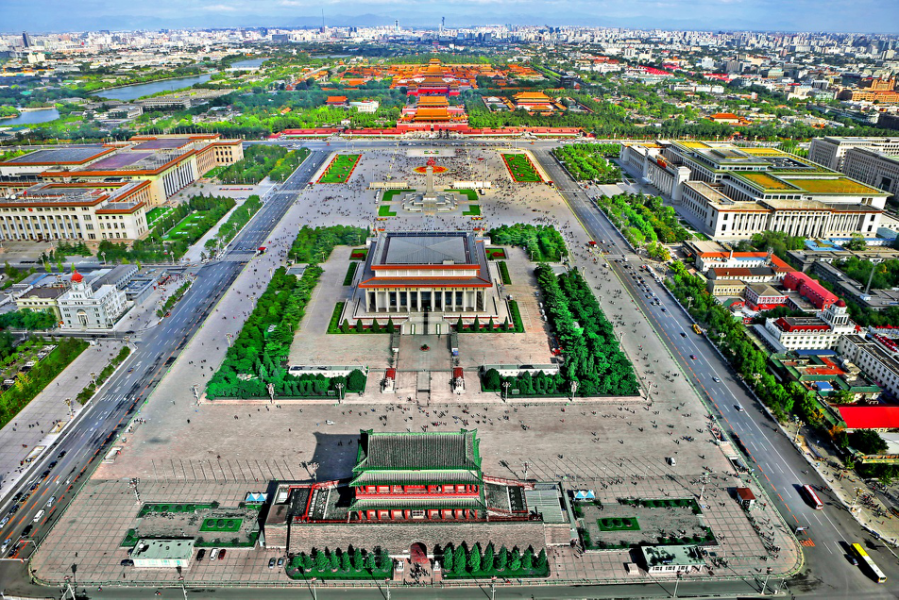
Beijing Central Axis (Photo by Zhang Yan)
Beijing has an age-old and mysterious urban axis. Established in the Yuan Dynasty (1271-1368), it serves the function of a "book spine", connecting the north and south of the city and forming a unique Beijing city pattern of bilateral symmetry and solemnity. Liang Sicheng has defined the central axis as one "that dominates the overall pattern of an ancient major architectural complex in China", the Central Axis.
Ancient Chinese "founded a state at the center of the world, and built the imperial palace at the center of that state". The Central Axis is the backbone and soul of the ancient capital of Beijing. Functioning as the ridge and spirit of the ancient capital, Beijing Central Axis represents the values of precision, moderation, orderliness and hierarchy, as well as the faith in humans as an integral part of nature. Moreover, it reflects the impact traditional Chinese ideology has exerted on urban architecture.
"Is Beijing Central Axis a straight line? How long is it? Why are there so many slanting streets in Beijing? Why do old Beijingers always say 'nine gates for different vehicles'"? Many little-known stories have taken place on the Central Axis of Beijing, leaving unsolved historical mysteries. Now, let's set off on a journey that transcends time and space to explore the mysteries of the Central Axis of Beijing.
Tracing · Ancient Legends
A view of regarding the North Pole as the center was first developed in prehistoric primitive tribes, marking the initial stage of urban central axis. Although people in the past dynasties strove to form such an entity, it was not until the Yuan Dynasty that a pattern most approximating the one proposed in the Rites of Zhou: Book of Diverse Crafts was established. That pattern of an ideal capital actually contains the rudiments of Beijing Central Axis. During the Ming and Qing dynasties (1368-1911), Beijing Central Axis was further developed and eventually completed.
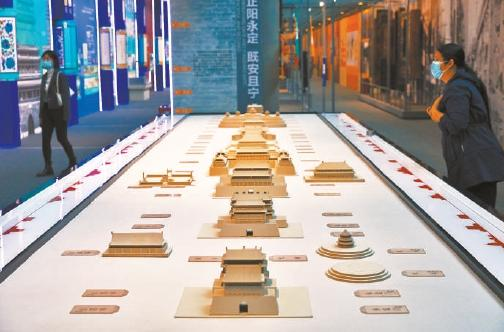
An architectural model of the Central Axis on display at the Capital Museum (Photo via Beijing Evening News)
The Central Axis of Beijing is the axis of east-west symmetry since the Yuan, Ming and Qing Dynasties (1271-1911), with a total length of 7.8 kilometers. Beijing Central Axis, which dates back to 1267, was formed and perfected in Ming and Qing Dynasties and modern times (1840-now). It is the largest-scale and best preserved one among the existent urban central axes in China and is regarded as a vivid example of sophisticated capital planning in the country.
Beijing Central Axis is an urban space complex composed of a series of architectural complexes, historical landmarks, historical roads, bridges and relic sites, with clear requirements on the position and orientation of each other. Although it adopts the form of a single axis, it has a complex spatial order. There is a ring structure of three walls in the center, and a corresponding relationship between space distribution and function around. Among the central axes of famous cities in the world, the Central Axis of Beijing boasts the most rigorous spatial logic and the most abundant connotations. In terms of its position, the adjustment of Beijing Central Axis in the Ming Dynasty (1368-1644) strengthened the original planning concept, and set the palace city in the more central position of the imperial city. In terms of its orientation, after the expansion of the southern part of Beijing in the Ming Dynasty, the Forbidden City was located in the middle and north of the whole city, in line with the concept of "facing south to honor the Sun" and "facing south to symbolize kingship". It is a long distance from Yongding Gate to the imperial palaces, flanked by Temple of Agriculture, Temple of Heaven, Imperial Ancestral Temple and Altar of Land and Grain. Tian'anmen used to have a narrow passage called the "corridor of a thousand steps". The journey to the imperial palaces is full of ritual and sacredness.

(Photo via InBeijing) (Official Wechat of Beijing Municipal Commission of Planning and Natural Resources)
The formation of the Central Axis of Beijing is closely related to the planning and construction of the Yuan Dynasty. In the fourth year of the Yuan Dynasty (1267), the capital of the Yuan Dynasty began to be established on the basis of the Palace in the Moon which was built in the Jin Dynasty (1115-1234) on Jade Flowery Islet (now Beihai Park). As for its planning and design, the central platform was first set up on the northeast bank of Jishuitan (the Drum Tower today), and the central pavilion was established. A south-north line extending from the central platform was determined as the central axis of the city, which is the historical source of Beijing Central Axis. In the 32nd calendar year of the Jiajing reign (1553), he expanded the outer city and built Yongding Gate. By then, the Central Axis of Beijing from Yongding Gate in the south to the Bell and Drum Towers in the north which measures about 7.8 kilometers in length had been completed. In the 26th calendar year of the Guangxu reign in the Qing Dynasty (1644-1911), the Central Axis began to suffer a certain degree of damage. Since the founding of the People's Republic of China in 1949, Beijing Central Axis has been undergoing various changes in preservation and planning.
Narration · New Outlook
As the time passed, various dynasties rose and fell in succession. After the monarchical system eventually perished, Beijing Central Axis, before an important carrier of imperial authority, saw great changes in its destiny and eventually found fresh justification in the new concept of urban construction. The feudal imperial facilities, such as the Forbidden City, Tian'anmen Square, altars and temples, gradually became places to serve the public. The change of function complies with the requirements of the new era and demonstrates historical progress. With its northward and southward extension and as its application for World Cultural Heritage listing approaches, Beijing Central Axis which has witnessed various vicissitudes springs into life again, just like the city it dissects.
After the founding of New China, a major change took place in the role of the Forbidden City, as the center of Beijing Central Axis began to move south to Tian'anmen Square. A series of cleverly designed buildings have come into being. Tian'anmen Square, National Flagpole, and the Monument to the People's Heroes have become the core part of architecture on the Central Axis. The Great Hall of the People has been established symmetrically 200 meters south of Altar of Land and Grain. Ancient Chinese people believed "The people are the most important element in a nation; the spirits of the land and grain are the next; the sovereign is the lightest." The Great Hall of the People, as the deep meaning its name suggests, is where people's representatives participate in politics. 200 meters south of Imperial Ancestral Temple where the royal families worshipped ancestors were the History Museum and Revolution Museum (now renamed the National Museum of China), which also highlight deeper connotations of historical inheritance. In this century, the north end of the Central Axis has been extended to Beijing Olympic Park from the Bell and Drum Towers. Not only the length of the axis has changed, but also a number of large-scale sports facilities have been built on this end point, so that the Central Axis now shows different rhythm. The "Bird's Nest" and the "Water Cube" (the National Aquatics Center), are located on two sides of the north end of the Central Axis, forming a symmetrical pattern.

Beijing Central Axis
A consensus has long been reached on protecting Beijing's old city area and the Central Axis. At present, Beijing is applying for its Central Axis to be included in the list of world cultural heritage sites. In 2011, the Beijing Municipal Committee of the Chinese People's Political Consultative Conference (CPPCC) suggested starting the legislative process for the overall protection of the Central Axis. The same year witnessed the start of application for Beijing Central Axis to be included as a world cultural heritage site. In 2013, it was included on UNESCO's Tentative List for World Cultural Heritage Site nominations. At present, identified heritage points on the Central Axis are Yongding Gate, Temple of Heaven, Temple of Agriculture, Zhengyang Gate and Arrow Tower, Tian'anmen Square Historical Architecture Complex, Tian'anmen, Imperial Ancestral Temple, Altar of Land and Grain, Palace Museum, Jingshan, Wanning Bridge, Bell and Drum Towers. The work of drafting the application, preparing the protection and management plan, formulating local laws and regulations, and implementing protection and renovation is being vigorously promoted. Beijing's Protection and Development Plan for the Historical and Cultural City During the 14th Five-Year Plan Period was released in August 2021, stressing the role of the Central Axis, Three Hills and Five Gardens, and three cultural belts. A stone water beast has been unearthed at the Zhengyang Bridge site, an important node on the Beijing Central Axis, according to the Beijing Municipal Cultural Heritage Bureau. The crucial archeological achievement has once again drawn great attention to the topic of the Central Axis.
Exploring · Bearing of a Great Power
From Yongding Gate to the Bell and Drum Towers via Zhengyang Gate, Tian'anmen, Taihe Palace, Jingshan Mountain, Beijing Central Axis connects the outer, inner and imperial city with the imperial palace. The main buildings along the central axis are symmetrical and staggered in height, thus creating a unique and magnificent picture. In addition to forming the ridge of the frame of Beijing city, Beijing Central Axis serves as the best embodiment of the capital’s boundless charm that makes it a famous historical and cultural city. Let's explore the past and witness the grandeur.
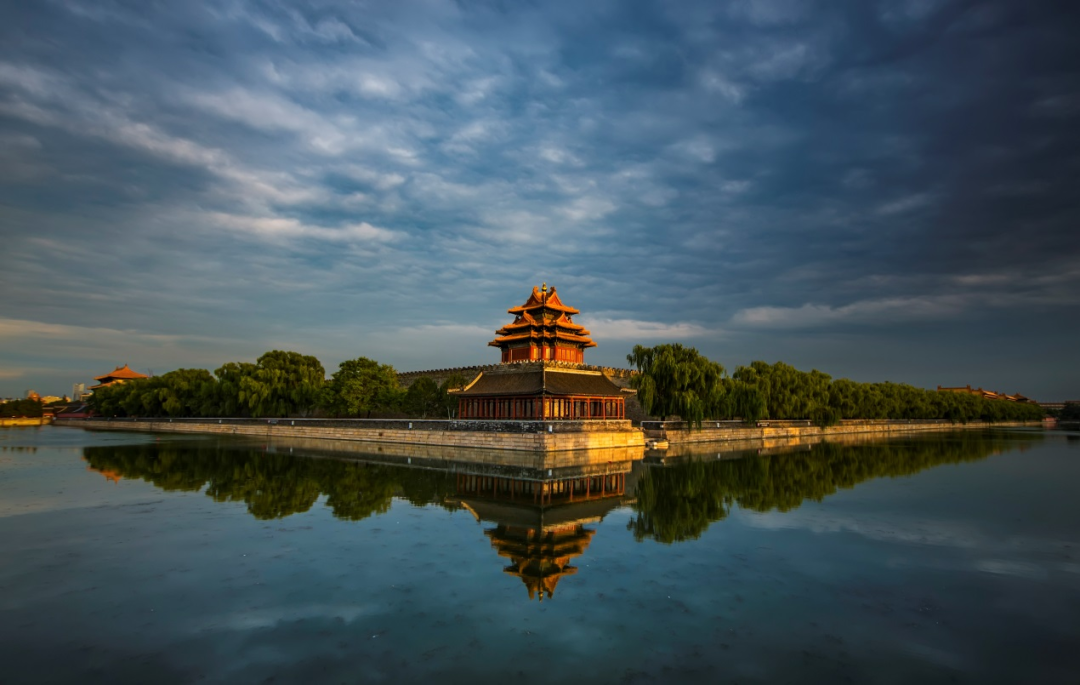
The Palace Museum Watchtower
The Central Axis of Beijing which links the ancient times and the present has experienced the changes of times and witnessed the continuous development of the Chinese civilization. Today, it is still clearly visible from the south to the north. But vehicles and honor guards of the royal families have already become a thing of the past. Instead, it embraces the general public, and witnesses the Chinese nation moving forward step by step in the ever-changing world.
The admirable ancient architectural wonder will shine ever more brightly today. Nowadays, the application for the world heritage status of Beijing Central Axis has been included in the core area planning, and this amazing urban landscape is becoming a development axis that highlights the protection of the ancient capital and the development of the city. In the future, it will continue to glow with vibrant charm and nourish the Chinese civilization which stands in the East of the world with a calmer and more confident posture.

Yongding Gate
Yongding Gate, the front gate of the outer city wall of Beijing during the Ming and Qing Dynasties, was built in the 32nd calendar year of the reign of the Ming Emperor Jiajing, meaning "permanent stability". The two-story gate tower is five jian (24 meters) wide and two jian (10.5 meters) deep, trimmed with grey pantiles and green glazed tiles in the double-eave and Xieshan style. It has become a veritable "city landmark" in Beijing, witnessing the historical changes of Beijing.
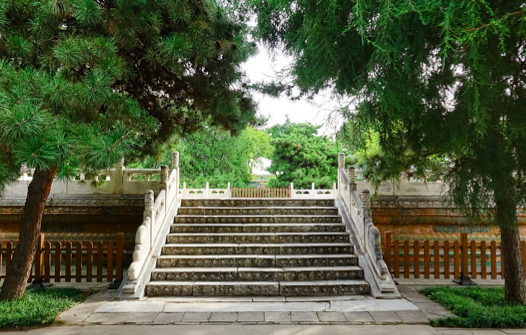
Temple of Agriculture
Located at No. 21 Dongjing Road, Xicheng District, Beijing, the Temple of Agriculture was built southwest of Zhengyang Gate, corresponding to the Temple of Heaven complex in the east. It was a place for the royal families of the Ming and Qing Dynasties to perform sacrifices to Xiannong, the mythical Emperor Yandi (c. 2900 BC-2800 BC). Beijing Ancient Architecture Museum inside Temple of Agriculture holds a self-contained exhibition of Ancient Chinese Architecture in the history of world architecture, which all the buildings of the Temple of Agriculture are part of, so that visitors will have immersive experiences and better appreciate the charm of national culture and art.
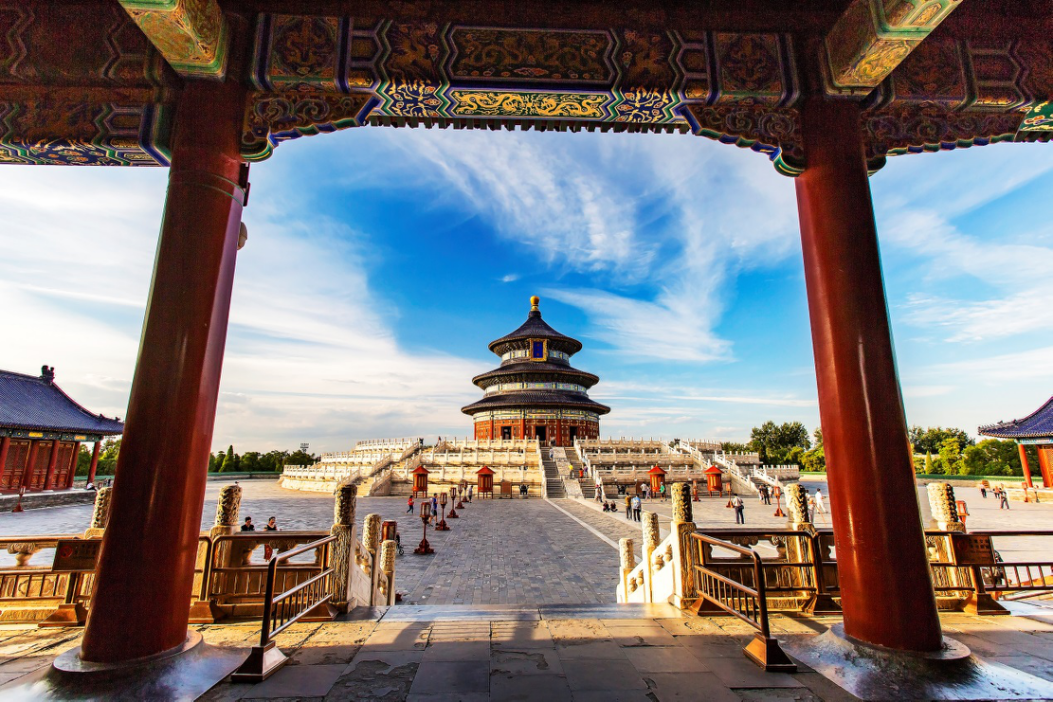
Temple of Heaven
The Temple of Heaven is located in the southeast of the former outer city of Beijing, southeast of the Palace Museum and the Zhengyang Gate. It was a place where emperors of the Ming and Qing Dynasties offered sacrifices to Heaven at the winter solstice and prayed for an abundant grain harvest on the 15th day of the first lunar month. It was included in the World Heritage List in 1998. The Temple of Heaven Park is a national key protected cultural relic unit, a national 5A-rated tourist attraction, and a National Scenic Area civilized demonstration site.
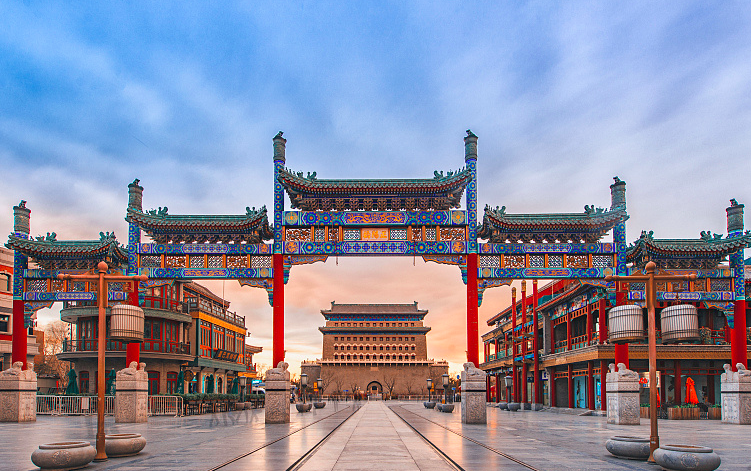
Zhengyang Gate
Zhengyang Gate, commonly known as Qianmen Gate, is a national key protected cultural relic unit, located on the Central Axis of Beijing, south of Tian'anmen Square, and north of Qianmen Street. It was the front gate of Beijing's inner city during the Ming and Qing Dynasties, composed of Wengcheng Arrow Tower in the south and the front tower in the north. The Arrow Tower has upturned eaves on two floors, and watch windows for shooting arrows on four floors, the first floor platform surrounded by white marble fence. The glazed tile roof features lifelike flying dragons raising their heads.
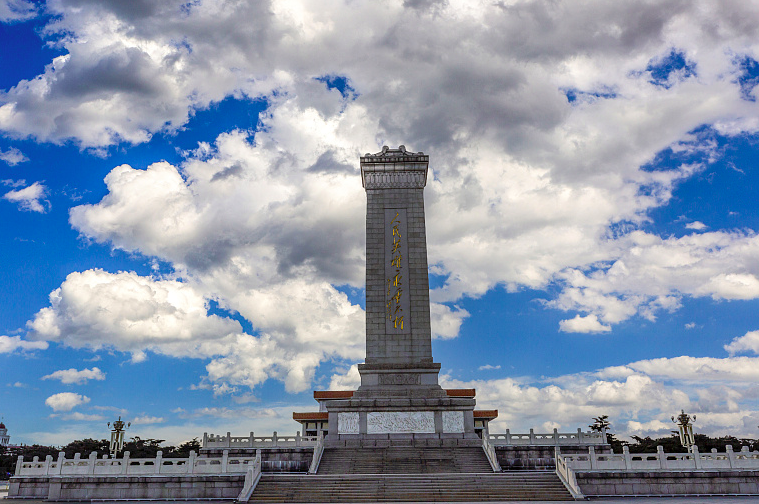
Monument to the People's Heroes
The Monument to the People's Heroes is located in the center of Tian'anmen Square in Beijing, on the north-south Central Axis. It is a monument built by the Government of the People's Republic of China to commemorate the revolutionary martyrs in China's modern and contemporary history. On March 4, 1961, it was selected by the State Council of the People's Republic of China as one of the first batch of national key protected cultural relic units. The monument is 37.94 meters high. The front (north side) of the monument is a whole piece of granite which measures 14.7 meters in length, 2.9 meters in width, 1 meter in thickness, and 60.23 tons in weight. The inscription shows eight gold foil characters "The People's Heroes Are Immortal".
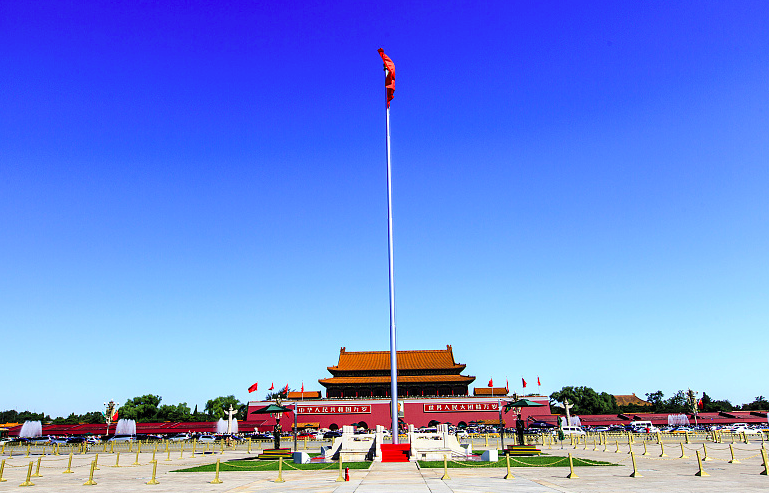
Tian'anmen Square and Rostrum
Located in the center of Beijing, Tian'anmen Square is 880 meters long and 500 meters wide. It covers an area of 440,000 square meters and can hold a grand gathering of one million people. Along the Central Axis of Beijing from north to south stand the National Flagpole, Monument to the People's Heroes, Chairman Mao Memorial Hall and Zhengyang Gate Tower. Tian'anmen Square is the site of numerous important political and historical events and the historical witness of China's decline and rise.
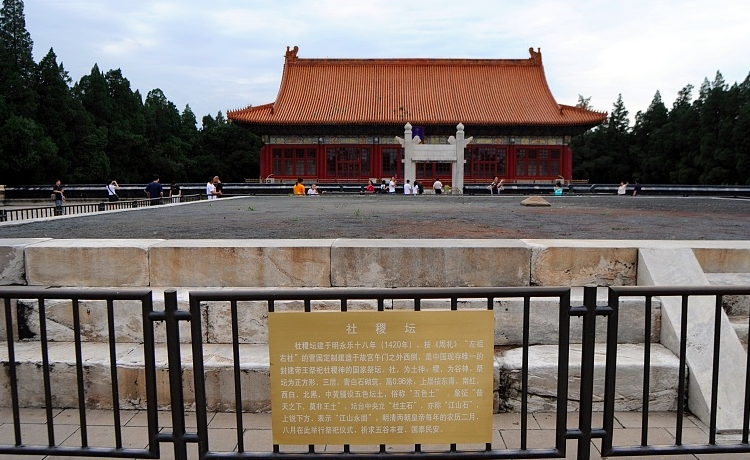
Altar of Land and Grain
Located in the west of Tian'anmen Square, West Chang'an Street, Dongcheng District, Beijing, the Altar of Land and Grain covers an area of about 360 mu (24 hectares). It was built in 1420, the 18th calendar year of the reign of Ming Emperor Yongle. It was a place where emperors of the Ming and Qing Dynasties offered sacrifices to the gods of land and grain. The Altar of Land and Grain and the Imperial Ancestral Temple are located on the left and right of Tian'anmen Square, corresponding to each other across the north-south central axis and reflecting the design principle of the imperial capital. Main buildings are Altar of Land and Grain, Bai Dian (Worship Hall), and subsidiary buildings including Ji Men, Sacrificial Storehouse, Sacrificial Kitchen, and Slaughter Pavilion. In the early stage, the Altar of Land and Grain (Sheji) was set up separately, namely the Grand Altar of She and the Grand Altar of Ji, to worship the God of She and the God of Ji. Later, they gradually integrated into one for worshipping activities.
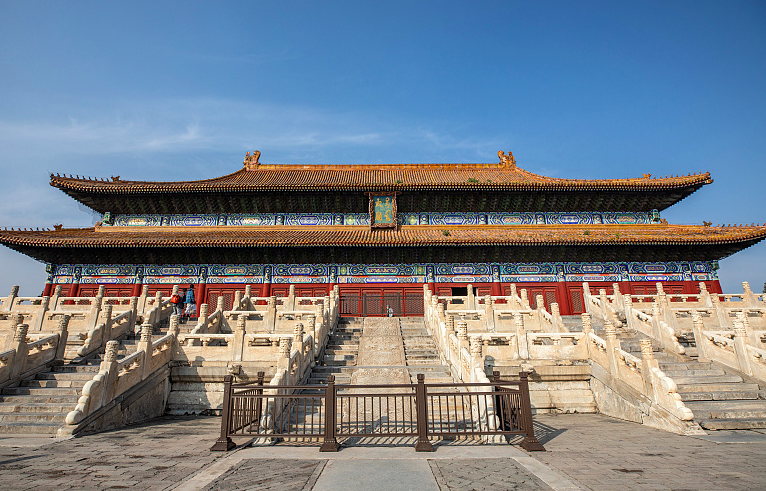
Imperial Ancestral temple
The Imperial Ancestral Temple is located on East Chang'an Street, Dongcheng District, Beijing, east of Tian'anmen Square, . It was built in the 18th calendar year of Ming Emperor Yongle (1420), covering an area of 139,000 square meters. It was a place for emperors of the Ming and Qing Dynasties to worship their ancestors, and was renamed "Beijing Working People's Cultural Palace" in 1950 and officially opened to the public. As an integral part of the Forbidden City, the temple is located in the protective buffer zone of the Palace Museum, which has been designated as a world cultural heritage. It was built at the same time with the Forbidden City according to the ancient architectural pattern of "ancestral temple on the left and altar of land and grain on the right". It has survived the Ming and Qing Dynasties and is among the best preserved and largest architectural complexes of imperial ancestor worship in China.
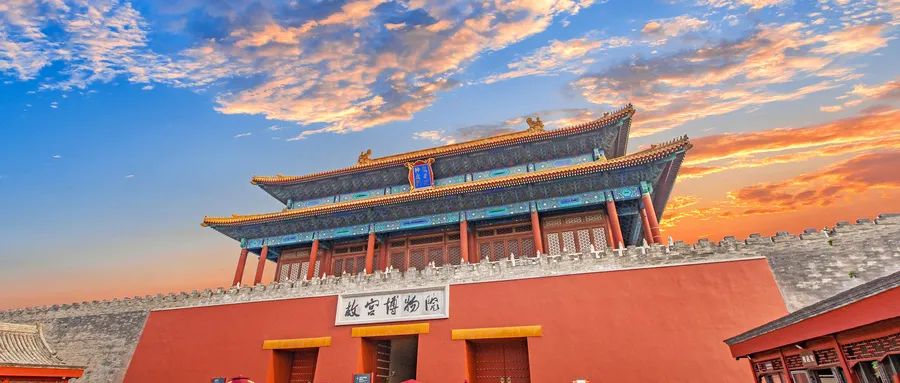
Palace Museum
The Palace Museum in Beijing, formerly known as the Forbidden City, is the imperial palace of China's Ming and Qing Dynasties located at the center of Beijing Central Axis. It is one of the largest and best-preserved ancient wooden structures in the world, and a national 5A-rated tourist attraction. It was included in the first batch of national key protected cultural relic units in 1961 and became a World Heritage Site in 1987.
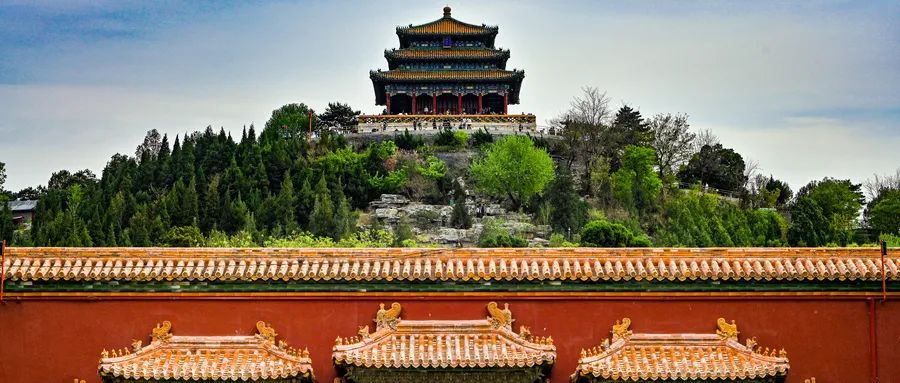
Jingshan Park
Jingshan Park is situated in Jingshan Qianjie, Xicheng District, Beijing, sitting on Beijing Central Axis of the Ming and Qing Dynasties. Facing Beihai in the west and the Shenwu Gate of the Palace Museum across the street in the south, it used to be the imperial garden of the Ming and Qing Dynasties. Jingshan, the earthen hill at the center of the park, was once the highest point in the city.
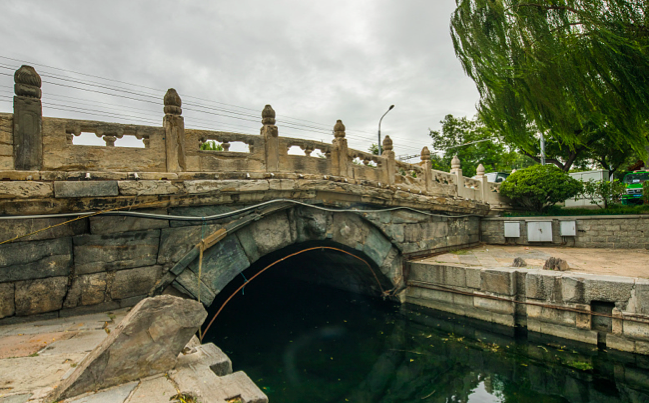
Wanning Bridge
Wanning Bridge, also known as Houmen Bridge and Di'an Bridge, is located outside Di'an Gate of Beijing. Sitting at the junction of Beijing's Central Axis, six "seas" (water areas) and Tonghui River, it serves as the reference point of Beijing Central Axis. This bridge was built in the 22nd calendar year of the reign of the Yuan Emperor Shizu during the Zhiyuan era (1285). Since it sits north of the Di'an Gate, which is the back gate of the imperial city, the bridge is also called the Houmen Bridge (back gate bridge). In 1984, it was listed as a protected cultural relic unit of Beijing.
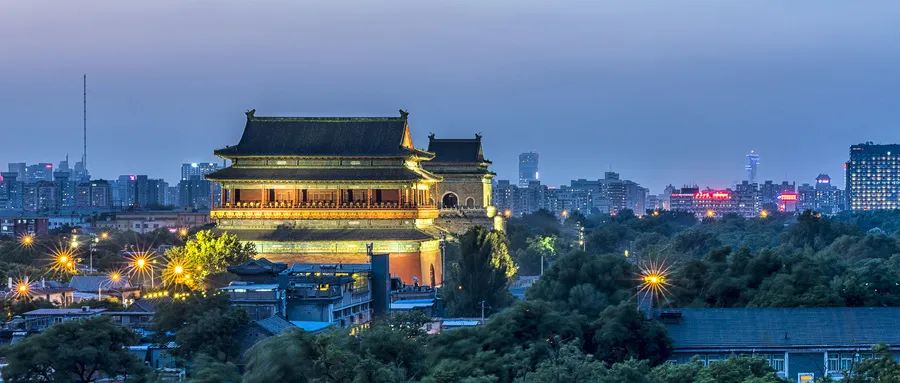
Bell and Drum Towers
Beijing Bell and Drum Towers are a group of ancient buildings located at the northern end of the north-south Central Axis of Beijing, and they were mainly used to tell the time in ancient China. The two visibly prominent constructions, placed fore-and-aft, present a spectacular scene, and showcase the wisdom and strength of the ancient Chinese working people. In the construction history of urban bell and drum towers, Beijing Bell and Drum Towers boast the largest scale and highest standards of architecture. They are not only the landmark buildings of the ancient capital of Beijing, but also important constructions witnessing the historical development of China in the past 100 years.